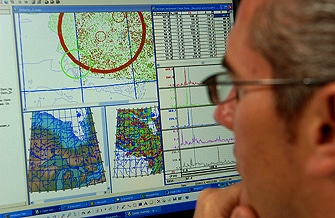There was a time when the biggest data problem within the geosciences was the dearth of data, not enough data to support discovery and exploration projects. As more of the world’s earth data is collected, digitized and stored in private, corporate and public databases, the problem has quickly become how to deal with the digital geoscientific data explosion.

How are you connecting with your data?
There are now vast amounts of available data, and the challenge is how to help geoscientists connect with it to solve their discovery puzzle – whether that’s pinpointing where to explore for minerals, oil, or understanding the characteristics of an environmental site for remediation.
Geoscientists need to be able to find data, evaluate it based on information about the data (metadata), retrieve it, either in native file formats or by translating the data directly into the context of their applications. Once found, verified and converted into a usable format, the data is analyzed, visualized, interpreted and used to support conclusions, and arrive at decisions that lead to action, which can be both critical and costly. This is the Data Experience, and it’s through this experience that geoscientists build knowledge from their data. In this article we take a look at how information management solutions and technologies are helping to improve the data experience, thereby contributing to reduced risk and better results for exploration companies and geoscience organizations.

The ultimate data experience
What is the ideal data experience? For many geoscientists, it’s about being able to find, connect and extract value from their data faster and easier. This means having easy access to all available data, and the applications needed to work with the data, via a single interface on their desktop. It’s the ability to quickly search and query from local databases and data servers, as well as public servers available on the Internet. It’s being able to count on the data’s quality and completeness. Finally, geoscientific discovery is an iterative and intuitive process, and the seamless flow of data – often multidisciplinary and available in different projections and formats – across applications is important. As is the ability to quickly add new data as it becomes available to continually evolve our understanding of a changing picture.
The benefits of better information management
Behind the scenes, there are solid business issues driving the requirement for stronger, centralized connections between people, workflows and their data assets. The case for investing in data management solutions often includes financial considerations, protecting and maximizing data asset value on the one hand, and minimizing cost of discovery on the other.There are also security issues, quality issues, and compliance with regulatory requirements.
Formal information management solutions address many of these issues, significantly increasing the value of data and information resources by establishing stronger connections between data and its consumers.
Improvements in information management help to focus geoscientists on the decision and not the workflow problems, by enabling them to spend more time on data interpretation and knowledge development and less time on data chores and data management issues. Having a consistently reliable flow of data to support projects, increases the number of projects that can be progressed within a given budget cycle. Organizing and managing your data supports effective collaboration and information sharing with consumers, partners and investors. It protects your investment in past data acquisition and makes old data more valuable by enabling it to be leveraged for future projects.
Developing an exploration information management strategy
Developing an exploration information management (EIMS) strategy that connects your data repositories with your data users, within the context of your organization, can be a daunting challenge. Here is a guide to some of the key characteristics of an EIMS solution, and some considerations when developing your EIMS strategy.
- Scope of EIMS. EIMS solutions must address the three key barriers to effective exploration information management: 1) getting exploration data and information into your company repositories, 2) creating a secure environment where data can be catalogued and metadata can be added, managed and maintained for data QC and compliance, and 3) getting information out to consumers in a usable and appropriate format.
- Simplicity. To add value information management has to immediately contribute to results and minimize efforts. Simplicity is the key here, and it starts with having the right process for getting data in and out of your system. EIMS must be supported with a single, well defined and easy process to get data in to the system. It must have one single, way for data users to extract data and get value from the system.
- Data Audit. Over the years, exploration data repositories become clogged with bad data while you are busy exploring. Based on working with multiple customers we have found that less than 60% of the data stored is actually used by explorers. The rest remains a mixture of duplicate, corrupt, irrelevant or unknown data that requires further investigation. To make the distinction between the good, the bad and the unknown, explorers must first review and audit data including drillholes, geophysical and geochemical data, technical reports and other project data. As a result of the review, good data is reorganized, bad data is removed, and unknown data is set aside for follow up.
- Data Delivery. Most important is having a solution to connect explorers with your back-end data repositories. The reality of having multiple data sources, each with its own data access methodologies, limitations and capabilities, complicates data search, extraction and delivery to endusers. Every company needs a standard system for publishing exploration data and making it instantly accessible to its geoscientists. Organizing information into consistent data types using all available metadata is crucial at this point.
- Performance. There are performance issues inherent in accessing the very large data sets consumed in exploration. Server technology exists to help resolve these issues. For example, Geosoft DAP Server performs the function of extracting, windowing, translating, compressing and streaming data to its clients. Repository technologies typically require high-bandwidth access to the data stores. Server technologies, like DAP, can provide data access over low-bandwidth connections.
Integration and implementation of your EIMS, and its overall fit within your organization is critical to making it all work for you. Choose solution providers that have experience with large volume geoscience data, and the services to support your roadmap development, systems integration and global implementation (if that’s required in your organization).
Making use of the cloud for collaboration
With the maturity of cloud architecture, and its growing application for big data management, online platforms are now available to securely share large, critical documents with external stakeholders. These ‘virtual data rooms’ can provide a turn-key solution for how you share and collaborate with your data electronically with business partners, investors and external third parties. They remove all the headaches related to managing security and providing access to large reports and time-critical communications related to: debt and equity financing, joint ventures and investor reporting. Low cost and ease of deployment are two of the major advantages of using data room services for your corporate communications.
At the end of the day, it’s about reducing risk and increasing both the speed, time to market, and quality of business decisions to improve results. Stronger data connections deliver better results.





